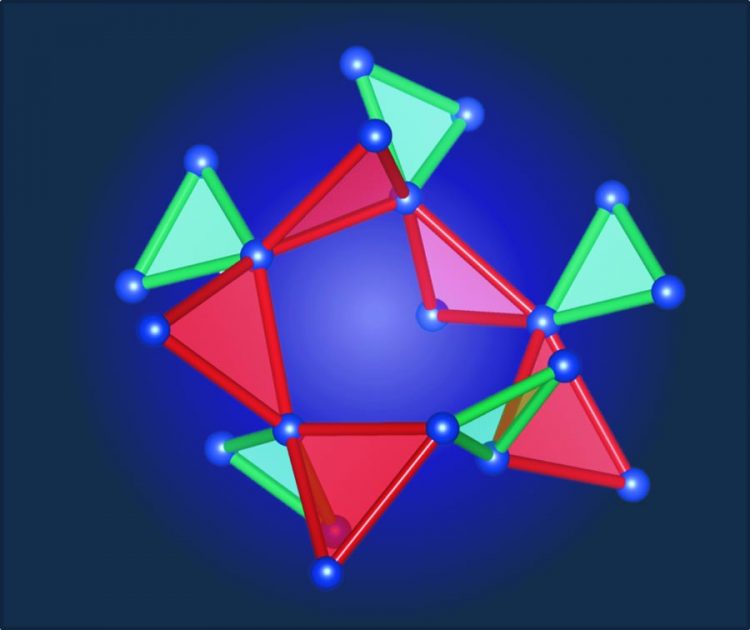Future information technologies: 3D Quantum Spin Liquid revealed

Two of the four magnetic interactions form a new three-dimensional network of corner-sharing triangles, known as the hyper-hyperkagome lattice, leading to the quantum spin liquid behavior in PbCuTe2O6. © HZB
IT devices today are based on electronic processes in semiconductors. The next real breakthrough could be to exploit other quantum phenomena, for example interactions between tiny magnetic moments in the material, the so-called spins.
So-called quantum-spin liquid materials could be candidates for such new technologies. They differ significantly from conventional magnetic materials because quantum fluctuations dominate the magnetic interactions:
Due to geometric constraints in the crystal lattice, spins cannot all “freeze” together in a ground state – they are forced to fluctuate, even at temperatures close to absolute zero.
Quantum spin liquids: a rare phenomenon
Quantum spin liquids are rare and have so far been found mainly in two-dimensional magnetic systems. Three-dimensional isotropic spin liquids are mostly sought in materials where the magnetic ions form pyrochlore or hyperkagome lattices.
An international team led by HZB physicist Prof. Bella Lake has now investigated samples of PbCuTe2O6, which has a three-dimensional lattice called hyper-hyperkagome lattice.
Magnetic interactions simulated
HZB physicist Prof. Johannes Reuther calculated the behaviour of such a three-dimensional hyper-hyperkagome lattice with four magnetic interactions and showed that the system exhibits quantum-spin liquid behaviour with a specific magnetic energy spectrum.
Experiments at neutron sources find 3D quantum spin liquid
With neutron experiments at ISIS, UK, ILL, France and NIST, USA the team was able to prove the very subtle signals of this predicted behaviour. “We were surprised how well our data fit into the calculations. This gives us hope that we can really understand what happens in these systems,” explains first author Dr. Shravani Chillal, HZB.
Picture: One of the four magnetic interactions leads to a three-dimensional network of corner-sharing triangles also known as the hyperkagome lattice. Combined the magnetic interactions form a hyper-hyper-Kagome lattice which allows the 3D quantum spin liquid behavior.
Dr. Shravani Chillal
E-Mail: shravani.chillal@helmholtz-berlin.de
Prof. Dr. Bella Lake
E-Mail: bella.lake@helmholtz-berlin.de
DOI: 10.1038/s41467-020-15594-1
http://dx.doi.org/10.1038/s41467-020-15594-1
https://www.helmholtz-berlin.de/pubbin/news_seite?nid=21301;sprache=en;seitenid=…
Media Contact
All latest news from the category: Information Technology
Here you can find a summary of innovations in the fields of information and data processing and up-to-date developments on IT equipment and hardware.
This area covers topics such as IT services, IT architectures, IT management and telecommunications.
Newest articles

Microscopic basis of a new form of quantum magnetism
Not all magnets are the same. When we think of magnetism, we often think of magnets that stick to a refrigerator’s door. For these types of magnets, the electronic interactions…

An epigenome editing toolkit to dissect the mechanisms of gene regulation
A study from the Hackett group at EMBL Rome led to the development of a powerful epigenetic editing technology, which unlocks the ability to precisely program chromatin modifications. Understanding how…

NASA selects UF mission to better track the Earth’s water and ice
NASA has selected a team of University of Florida aerospace engineers to pursue a groundbreaking $12 million mission aimed at improving the way we track changes in Earth’s structures, such…





















